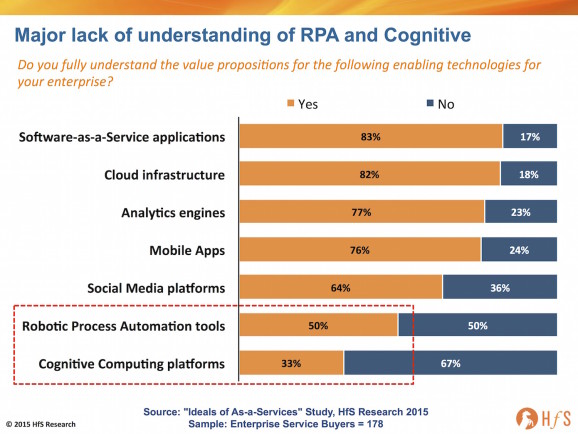
Skeptical? You should be…
Admit it, people, you’re all being subjected to presentations from many service providers and advisors that have become so confusing you’re actually too embarrassed to say: “I really haven’t got a clue what you are trying to pitch me here”.
In many cases, you suspect the suit presenting it to you probably doesn’t have much of a clue either, so you just zone out and permit him to portray painfully his pre-scripted, professionally puffed-up, potpourri of PowerPoint.
I don’t believe I’ve ever witnessed a time our services “industry” has descended into such a mind-numbing pattern of meaningless marketing hype and unintelligible bullsh*t. It was bad enough when everyone was painting pretty pictures of “transformation” to sugar-frost labor arbitrage deals, but at least we could understand the bullsh*t and detect its scent a mile away.
Today, we’ve fallen even deeper into a trough of verbose desperation, as most service providers and advisors replicate each others’ sales decks to reel off an increasingly inane plethora of confused rubbish, that is transcending further and further away from reality. In most cases, this is much worse than mere sales hype, it is hype and confusion squished together in such a confused steaming mess, it leaves most of us speechless to even question it. How can you ask sensible questions, when you just don’t really understand what you’re being presented?
When we questioned the understanding of today’s technology enablers with 178 experienced service buyers, the results are quite alarming – and telling:
Despite being the most hyped technology to hit the services market in the last three years, only 50% of service buyers actually understand what Robotic Process Automation is? And only a third grasp what cognitive computing platforms are? How many more millions need to be spent on these newfangled cognitive/autonomic platforms until the people who are their prospective customers actually understand what the hell they are? How many more millions do these providers, analysts and advisors need to spend on stroking each others’ egos at expensively assembled boondoggles, before they realize their actual prospective customers haven’t got a bloody clue what they are talking about? How many more millions are going to be spent on marketing campaigns that just leave us scratching our heads, confused as to what is actually being sold?
Some vain suggestions to get us back to something closely resembling reality
Invest in executives who can hold meaningful conversations with your clients. “We’re just not talking to the right people,” confined one service provider leader to me recently. We quickly came to the conclusion this was because his firm had not recruited the right people to have the right conversations with the right level of people. This is where service providers and advisors have to invest, if they are going to make it past this era of BS. Too many are skimping it with cheaper kids and inexperienced sales people who just don’t have the chops and years of experience on the client side, to get them to open up about their challenges and create interest in hiring them. We’re not just selling a software product here, we’re selling services to address fundamental business pain points. So waste less money on meaningless marketing and ineffective sales people, and find the talent which can hold the conversations you need to be successful. Be unafraid to change the failing recruitment model in this business – there are hoards of really smart, articulate, experienced people out there. Otherwise, you will probably fail.
Kill the PowerPoint. I can’t believe I am still talking about this one, but it’s got even worse in most cases. And the PowerPoint’s got even more canned and scripted. It’s become an excuse not to have a meaningful conversation. It’s become the glitz the ineffective sales guys can hide behind to avoid the meaningful conversations.
Start with the solution and get to the point. People will immediately resonate with you, when you articulate what you are trying to talk to them about. Never be afraid of the blindingly obvious – if people understand what you are talking about, you will get their attention. “Our solution can take out 40% of cost, like we already have for xxxx”… or “We can fix your manual processes in six months with our revolutionary new automation tool and here’s how we’ve done it”. Or “We are the leader for high value solutions in healthcare, or banking and this is why” etc. Don’t amble on with a dull build up to sound clever, and really avoid the canned Nascar slide, when it’s clearly a hodge-podge of logos of everyone who’s had some vague connection with you. It’s cheesy. And tone down the incessant use of flashy terminology – we all know it by now. Let’s revert to more plain English, please.
Bring real personalities into play, not sales people. As we discussed last week, the focus of work today is about increasingly about enjoying who you’re working with. People want to engage with people with charisma, who actually want to create relationships, not the old school sales rep who are “only selling”. We’re all in the relationship business and need to create long term relationships with our clients and partners, whether or not they buy from us today. People are still buying from people – especially as the technology becomes more and more commonplace. There is always a lot more forgiveness factor from clients for a sloppy transition or an over-budget implementation, where the relationships are true and strong. We might be in the era where technology is at the center of our world, but this means the real differentiation is with the people applying the technology.
The Bottom-line: We have to fix our bullsh*t problem, or this industry will fade into irrelevance
We’re in the business of helping clients run their operations more productively – that’s never changed. We’re not in the business of trying to be the smartest guy in the room. And we’re certainly not in the business of creating the largest array of pre-scripted canned marketing hype. It’s time to get back to basics, focus on the people we have fronting our capabilities and making sure our clients understand us – and are engaged with us. If we’re not, we might as well go home now, as others are coming along who are changing the conversation and having the meaningful dialog.
Posted in : 2015 As-a-Service Study, Business Process Outsourcing (BPO), Confusing Outsourcing Information, HfSResearch.com Homepage, IT Outsourcing / IT Services, Robotic Process Automation, SaaS, PaaS, IaaS and BPaaS, sourcing-change, Talent in Sourcing







You just make my weekend Phil. You nailed it.
Phil,
This got me nodding and nodding and nodding. Thank you!
Jeff
Excellent article. Two thoughts:
* Clients are feeding into this hype as they are loudly shouting “we want innovation not just arbitrage” then dumping their incumbents for a provider who is the same or worse but talked about new tech. So, providers feel like they have to hype it at mind-numbing levels or they will be labeled as out-of-date. A client will buy the same solution from a new provider with the hope of scaling to trasnformative tech, even if they don’t understand how it works. This is just a fact.
* Powerpoints can be excellent tools. But PPT just isn’t used well by sales teams. When some says they “don’t want powerpoint”, they really mean “I don’t want another bad powerpoint”. My teams and I use it to great practical effect. There are other neat tools like Prezi that work as well.
The industry has been prone to over promotion of individuals and over hype of services for a number of years and it surprises me that this is only now being discussed.
Customers will usually seek to work with those they know, understand and trust.
As a result of this the customer and provider are likely to develop, over time, mutual respect and possibly even a liking for each other.
After all who wishes to spend time with someone you do not like or respect?
Against this background there will be tough times but the customer is more likely to forgive if strong personal relationships exist.
However, developing these types of relationships does not happen overnight and today’ there seems to be a need for speed in all we do.
For me this situation is largely driven by fear – fear of the truth, of being left behind, not making the sale, not being promoted, looking stupid.
So we get a long line of people pedalling services and solutions as stable and immediately available, when patently they are not, and an over reliance on jargon and marketing hype to replace the ability to have a conversation.
Best approach is to go with a pad and pen, ask open questions and most importantly listen to what the customer says and be prepared to invest time in building the relationship.
@Phil Martie: you pretty much nailed it. The core of the problem here really is a lack of definition and purpose of the services business, and the fact we’ve got well ahead of ourselves, which I believe is a bifurcation between “cost reduction” and “value”. Everyone went into this with cost reduction via cheaper labor as the product, so we talked about how to achieve this, while not exposing the business to risk.
Most clients today still haven’t exploited the labor arbitrage lever as much as they can, which is why this industry still exists, however, the fundamental issue has been an underwhelming product – many clients are still struggling to get basic, operational processes executed and are holding their incumbent provider accountable. “Where are all these delights you promised me? You can’t even get our AP delivery right…”, so several are casting their eyes at some of the other purveyors of services to see if they can find some of that extra value. Sadly, the way several providers and advisors are presenting their “value” is resulting in this confused mess. They should be articulating their flawless execution capability, their ability to drive out xx% of costs for names clients, then can talk about investments in better tech/automation/self-learning etc to help process delivery to a new level. Instead, these guys are all just jumping on the innovation and tech, and losing sight of the real purpose of this business.
Someone once said “it’s all about people, process and technology”… and it’s never been more so today!
PF
@Michael Steer: For some reason, many of the guys fronting services are sounding like software salesmen. In fact, I am sure many of them were (still are) software salesmen selling labor elimination products (ugh). You are 100% right – this is about relationships and trust. As I just mentioned, we’ve got far too ahead of ourselves and dial the conversation back to flawless execution and productivity gains first, then investments in technology that can have significant future ROI.
PF
[…] That is the central if understated thesis behind Horses for Sources call for RPA in a re-imagined finance function. In a recent polemic Phil Fersht, HfS CEO said: […]